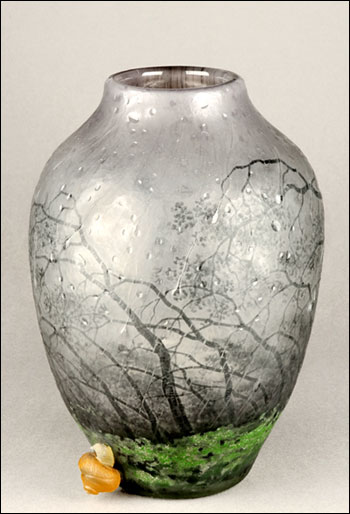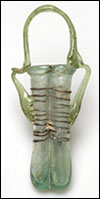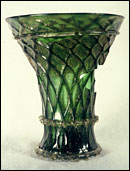
Antonin Daum, Rain vase, Nancy, after 1895, Strasbourg, Musée d'art moderne et contemporain
Photo : Mathieu Bertola |
|
MUSÉE D'UNTERLINDEN
1, rue d'Unterlinden 68000 Colmar
INFORMATION:
Tél. +33 (0)3 89 20 15 50 Fax : +33 (0)3 89 41 26 22 e-mail : Info@musee-unterlinden.com
Site : www.musee-unterlinden.com
OPENING HOURS:
Until April 30, open every day except on Tuesday: 9am-12am and 2pm-5pm
From May 2, open every day: 9am-6pm
Closed on May 1
PRICES OF ADMISSION:
Full rate: 7 €, Concessions for groups (15 persons minimum), seniors, carte Cezam: 6 €
Concessions: 5 € (12/17 and students).
Free for children under 12, teachers and accompanying adults
CURATORSHIP:
Frédérique Goerig
Suzanne Plouin
PRESS CONTACT:
Marie-Hélène Siberlin Tél. +33 (0)3 89 20 22 74 e-mail mhsiberlin@musee-unterlinden.com

|
The exhibition Wonders in glass in Alsatia brings together for the first time the most prestigious, most beautiful and most important glasses in the history of this art form, found in Alsatia. 300 glasses cover a large period that streches from the origins of this fine art (The Antiquity) to Art Nouveau (1900).
A great number of these works, whether they come from private collections or from public institutions, has come out of the dark for this show.
The Oriental side of the Mediterranean, birthplace of glassmaking
The exhibition starts with the Vth century B.C., and presents the oldest known glasswork, perfume bottles from Rhodes, moulded on a clay core. As soon as blown glass was invented in Syria, towards 50 B.C., the art of glass making started developing. Gallo-Roman glass factories in Western Europe and in the oriental side of the Mediterranean multiplied the forms and decorative techniques, and demonstrate the know-how and talent of the artisans. At the Merovingian time, forms were less audacious, and goblet making prevailed. Glass making during the medieval period prolonged this series, including goblets with very plastic decoration and enamelled glasses.
Illustration: Double balsamer, Eastern Mediterranean, Palestine; Jordan. Ivth-Vth centuries B.C. Strasbourg. Musée de l’Oeuvre Notre-Dame.
Photo: Mathieu Bertola.
From Venice to Vienna, the golden era
In the XVIth century Venice became the birthplace of the renaissance of glass in Europe: the quality, the variety of the decorations and its forms were the envy of all European courts. But competition came at the end of the XVIIth century with the invention of crystal in England and glass in Bohemia, in which the triumph of baroque art is seen in the virtuosity of the decorations. Cut and moulded crystal reached its golden age at the beginning of the XIXth century and became more democratic. As of the middle of the XIXth century, certain glassworkers reacted instantly to the mechanisation by creating prestigious pieces, inspired from ancient techniques.
Art Nouveau
At the end of the XIXth century, this return to a form of art and crafts opened the door to innovating techniques that led to Art nouveau, of which the leader in Nancy was Émile Galle searching for her inspiration in vegetable, animal and even mineral forms.
The Blaschkas’ sea invertebrates
In parallel, the exhibition presents for the first time a surprising collection of marine invertebrates done in glass in 1890 by two glassworkers from Bohemia, the Blaschka. This infamous ensemble, unique in France, and kept at the zoological museum in Strasbourg, is as exceptional for its delicacy as for its precision.
PUBLICATION
Catalogue of the exhibition. Texts by Frédérique Gœrig, Suzanne Plouin, Jean-Yves Feyeux, David Carita, Marie-Dominique Wandhammer and Henri Reiling, with photographs and notes on the 300 glasses presented. Editions la Nuée Bleue, Strasbourg, 160 p., 30€.
Illustration: Goblet with articulated inside surface Venice. End XVth century, beginning XVIth century.
Strasbourg. Private collection.
The BIX
The museum of Unterlinden asked the Centre International d’Art Verrier [CIAV] in Meisenthal to create a contemporary object in glass. Work that is half way between the V8 (Pierre Bindreiff and Sebastian Geissert, associate designers in Strasbourg) and the traditional glassworkers gave birth to BIX – a word which in the local dialect refers to a 33cl metal box containing various beverages .. The status of a mass produced object changed to give way to the sensitivity of the glass blowers’ breath. The Bix is published in a series limited to 333, numbered copies. Price : € 33.
|










